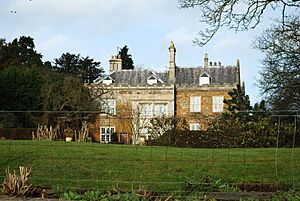William Skeffington facts for kids
Sir William Skeffington was an important English knight who lived from around 1465 to 1535. He served as the Lord Deputy of Ireland, which meant he was the King's main representative and governor in Ireland.
Contents
Early Life and Family
William Skeffington was born at Skeffington Hall in Leicestershire, England. He was the oldest son of Thomas Skeffington and his wife, Mary. His brother, John, was the first important member of the Massareene family line. William took over from his father in 1496.
William Skeffington's Career
William Skeffington had a long and active career serving the English kings.
Early Roles and Royal Service
He was chosen to be the High Sheriff of Leicestershire and Warwickshire in 1508, 1515, and 1521. A High Sheriff was a very important local official who helped keep law and order and represented the King in the county.
In 1509, King Henry VII made him a knight. From 1515 to 1534, he was the Master of the Ordnance. This meant he was in charge of all the King's weapons, cannons, and military supplies.
In 1520, William Skeffington joined King Henry VIII and other knights at a famous meeting called the Field of the Cloth of Gold. This was a grand event in France where King Henry VIII met with King Francis I of France to show off their wealth and power.
In 1523, King Henry VIII gave him some land near Tunbridge. Later, in 1529, he became a knight of the shire for Leicestershire. This meant he was elected to represent his area in the English House of Commons, which is part of the country's government.
Serving as Lord Deputy of Ireland
In 1529, William Skeffington was chosen to be the Lord Deputy of Ireland. He was meant to govern Ireland for King Henry VIII's son, the Duke of Richmond, who was the official Lord Lieutenant of Ireland.
He arrived in Ireland in August 1529. However, his power was limited by the King's instructions. For a while, Gerald, the 9th Earl of Kildare, was actually more in charge of Ireland than Skeffington.
In May 1531, Skeffington officially accepted the agreement of a Gaelic leader named Hugh Duff O'Donnell in Drogheda. This situation continued for three years. In 1532, Skeffington was called back to England.
Return to Ireland and Rebellion
In 1534, the Earl of Kildare was imprisoned in England. His son, Silken Thomas, started a rebellion in Ireland. Because of this, William Skeffington was asked to be Lord Deputy again, even though he was about 70 years old.
He was not keen to take on the role again because of his age and poor health. He also had disagreements with Leonard Grey, 1st Viscount Grane, who would later become Lord Deputy. Their arguments were said to have made Skeffington's health worse.
After some delays, he arrived in Dublin in October 1534. He immediately marched to help the town of Drogheda. However, his illness slowed down his efforts to stop the rebellion. In the spring of 1535, he was well enough to lead his army again.
He captured Maynooth Castle, a very strong fortress. He used heavy cannons during this attack, which earned him the nickname "The Gunner." He also managed to make some of Kildare's allies agree to peace and captured the town of Dungarvan.
Death and Legacy
Sir William Skeffington died in Kilmainham, Dublin, on December 31, 1535. He was buried in Saint Patrick's Cathedral, Dublin.
There is a monument in his honor in the local church at Skeffington. His oldest son, Thomas, took over his family's position.
Family Life
William Skeffington was married twice.
His first wife was Margaret Digby. She was the daughter of Sir Everard Digby of Tilton, Leicestershire. They had a son named Thomas Skeffington, who became his heir.
His second wife was Anne Digby. She was the daughter of Sir John Digby of South Luffenham, Rutland. Anne had been married before to John Bellers. William and Anne had several children together. One of their sons was Leonard Skeffington, who served as a soldier in Ireland and worked as a messenger for his father at the King's court. Leonard also became a Lieutenant of the Tower of London.


